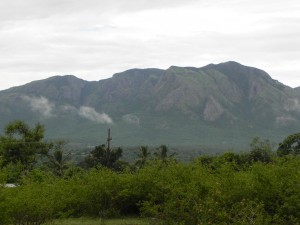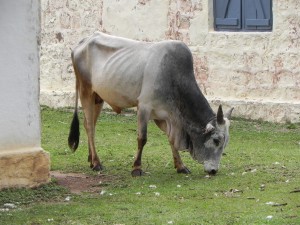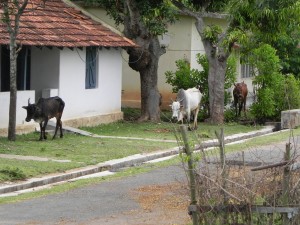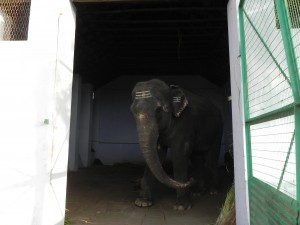June 1, 2010
Today I left Mudumalai for Coimbatore. Each place I stay has a distinct flavor, subtle differences that catch me by surprise. At first glance it seems that all the places are alike, but indeed, that perception is not correct.
The view from my India Institute of Science guesthouse provided an ever-changing array of activities; I nearly wore my camera out.
The spectacular mountain range directly in front of me.
Free roaming cattle even closer.
It has taken a bit of behavior modification on my part to stand back and observe the nonhuman animal life that is part and parcel of this culture. The animals are really not accustomed to being approached. They flee if too much attention is given to them. So I have learned to be satisfied with simply watching the cats, dogs, cattle, goats and pigs, just as I do the wild boar, monkeys and elephants, all going about their lives in complete synchronicity with one another.
Unique to any other place I have visited so far is the piped music coming from a towering speaker in the local village. The first night in Mudumalai, an hourly bell sounded from the loud speaker followed by a kind sounding message in a woman’s voice. I don’t know what the message was but from the tone of her voice, she was wishing everyone well.
On the first morning, when I heard the music and identified it was coming from the village area I thought to myself, “What if you are a villager and don’t want to listen to that particular music at that time?” Then I realized that it is a cultural thing. These villages seem to function as a group, many individuals and family providing different services to the community. Although each person is an individual, I believe that ultimately they operate as one. In such a social community I realize that group music could indeed be appreciated as a gift.
The drive to Coimbatore took us through some pretty treacherous mountains; when they say hairpin turn they are not kidding! The views were breathtaking. I continue to be overwhelmed by the richness of this culture and the mosaic of color, texture and sounds, all nature dependent.
It has taken me this long to finally realize that India is very animal welfare conscience. Learning something new is much easier than relearning, which explains my delay in recognizing just how welfare conscious the people are. Throughout the wildlife sanctuaries and national forests signs are posted instructing visitors not to harass, feed or touch the animals.
In Mudumalai, a main thoroughfare cuts through the park, providing access to two large cities. The traffic is nonstop. Along this stretch of road it is illegal to stop your vehicle or take photos. Signage with animated photographs reminds the traffic to drive slow, not disturb the animals and protect wildlife and the forest.
Without exception, forest officials, veterinarians and biologists all speak with one tongue when it comes to animal welfare. Animal welfare is understood as an integral part of the forest department’s responsibility. How refreshing to hear a high-ranking officer state that elephants should be treated without abuse and that their welfare is paramount. Listening as one official stated that elephants have feelings, too, brought a smile to my face and courage to my heart. Efforts for animal welfare are not considered controversial here in India.
Coimbatore was a pleasant surprise. The travel books warned that it was void of anything to do but that could not be more untrue. A bustling modern city, Coimbatore was actually a nice break, another variation of scenery and culture, as well as the home to the WWF India offices. I was escorted to two temples and just as my luck would have it our timing was perfect.
After driving through communities with roads hardly wide enough for a single jeep, we arrived at the Patteeswarar Temple. I was instructed to leave my slippers (shoes) in the jeep as slippers are not permitted in the temple. The moment we arrived at the ornate stone entrance I was overwhelmed by the sheer massiveness of the structure towering overhead. I snapped out of my trance when I heard, “Madam, madam, the elephant.” I realized almost too late that their calls were meant for me. I nearly missed seeing the full-grown elephant exiting the temple, walking mere inches behind me.
Kalyani has been the solitary female pachyderm resident of the temple for the past 17 years. Although the manager did not know her exact age she looked to be in her early thirties. Her daily temple duties concluded, Kalyani was heading home to her stable for the night.
Running, I tried to get ahead of Kalyani to take photos but her long legs hampered my efforts. Remember, I had left my slippers in the car so indeed I was barefoot. My escort/translators kept pace. The scene must have been comical: one crazy barefoot American lady and two well-dressed local men running along with the elephant with a vehicle following close behind. I really had to laugh. It is moments like this that I am reminded of how kind and helpful everyone has been, assisting with my fact finding mission on elephants.
Just when I succeeded in getting ahead of Kalyani and in position to take photos, the Phandis made a right turn along with Kalyani who ducked into the doorway of her stable. With precision executed with silent direction, Kalyani maneuvered herself into place for chaining. Her stable was a concrete structure with a metal screen door. I snapped as many photos as I could as Kalyani was secured for the evening. Fodder was laid out and two motorcycles that were leaning up against the wall were removed. In a matter of moments, it couldn’t have been a minute, Kalyani was secured in her stable and the mahout was ushering me out so he could close and lock the screen door.
The mahout indulged me for a few minutes as I asked questions that were translated to him. How old is she, how long has she been here? Does she go for grazing? Does she go for bathing? How much time does she spend at the temple? By this time the mahout clearly was done with all the questions and gestured that he was leaving. I looked at the screen door that divided Kalyani from the outside world and then surveyed the surrounding area. Kalyani’s stable was on a quaint, narrow dirt road with crowded residences and shops lining both sides of the street. I asked the mahout if he slept here with Kalyani and he said no, that he lived close by.
On the way out I noticed an expansive area with the lush vegetation, places where Kalyani could easily have foraged for food, providing her not only with live vegetation but also relaxation, distraction and natural substrate.
As I was still pondering Kalyani’s existence, we received permission to visit another temple elephant. We had gone to the temple earlier but the elephant was not there. Many times it’s difficult to gain permission from privately run temples so getting an invite was exciting.
Congestion is a way of life in India’s cities. Every manner of vehicle crowds onto the roadways and jockeys for a position closer to the finish line. I won’t lie and say I have become accustomed to being a passenger in this driver’s mayhem. I was excited to see my next temple elephant……




